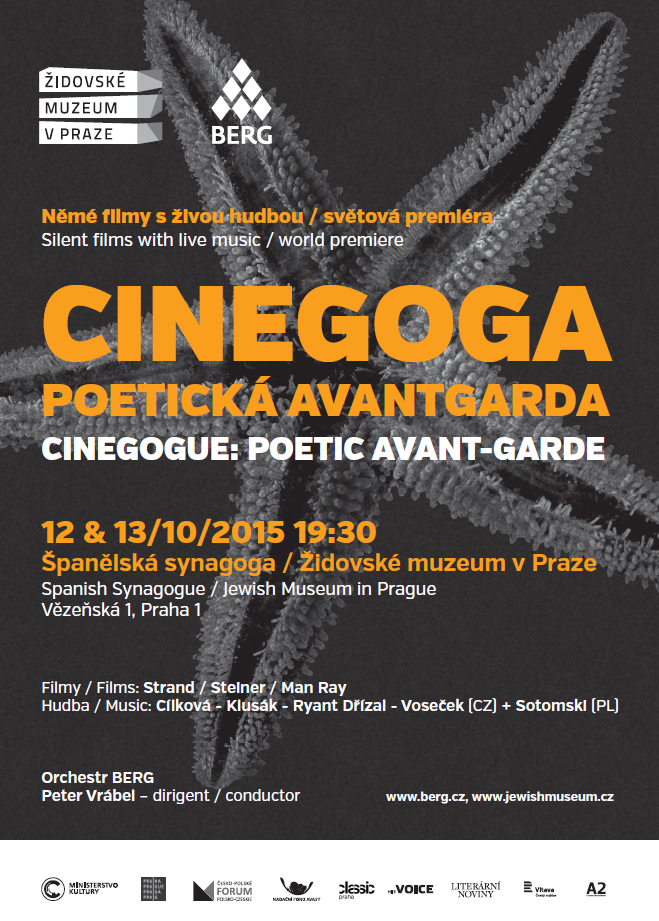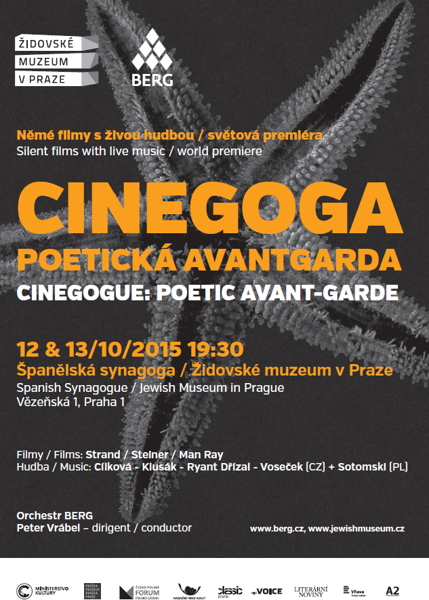Cinegogue: The Poetic Avant-Garde between Walt Whitman to Robert Desnos
12. 10. 2015 19:30 - 21:30
Spanish Synagogue, Vězeňská 1, Praha 1. Entrance 250/150 Kč.
 CINEGOGUE is a series that combines “cinema” with “synagogue” to screen silent films accompanied by live music in a historic space acclaimed for its architecture. Its mission is to uncover little known works of world cinematography to present a different view of Jewish culture and the artists of the post-emancipation period, which saw not only the inception of the international Zionist movement and the large waves of immigration from Central and Eastern Europe to the New World, but the frenetic growth of the avant-garde and cinema as well.
CINEGOGUE is a series that combines “cinema” with “synagogue” to screen silent films accompanied by live music in a historic space acclaimed for its architecture. Its mission is to uncover little known works of world cinematography to present a different view of Jewish culture and the artists of the post-emancipation period, which saw not only the inception of the international Zionist movement and the large waves of immigration from Central and Eastern Europe to the New World, but the frenetic growth of the avant-garde and cinema as well.
The world premiere of this year's event will take place at the Spanish Synagogue 12 October 2015, reprise is scheduled a day later, October 13th, 2015. Cinegogue is held in cooperation with the Berg Orchestra.
The Poetic Avant-Garde between Walt Whitman to Robert Desnos
Notes on the films and their auteurs
Paul Strand, Charles Sheeler
Manhatta (1920)
While it might be a bit presumptuous to call Manhatta one of the first attempts at documentary film, one could certainly agree that it is the first film in American cinematography intentionally conceived as experimental, becoming as well the precursor for “city films.” The main protagonist is the city of New York, a metropolis “proud and passionate” in the words of Walt Whitman (1819–1892), excerpts of whose verse appear in the film’s intertitles. One recognizes here the poem “City of Ships,” which was part of the originally separate volume Drum-Taps, containing poems from the time of the American Civil War, that was later incorporated into the ever-expanding collection Leaves of Grass. Though this poem forms the textual base for the film, it is excerpted and tailored to work symbiotically with the image.
Ralph Steiner
H2O (1929)
Mechanical Principles (1930)
These two cinematic compositions by Ralph Steiner from the turn of the 1930s are next to Paul Strand’s work another example of the interest American avant-garde photographers took in experimenting with the cinematic image. Having studied chemistry before he took up photography, it should come as no surprise that Steiner titled his first film after a chemical formula. Yet he was interested in water not as a chemical substance but as natural element endowed with uncommon properties, which in its amorphous liquid state reacts to external influences – light, gravity, and kinetic energy – with a fascinating play of reflections and textures, geometric patterns and effects bordering on an impeccable optical illusion. In his film Mechanical Principles a year later, Steiner is clearly still captivated by visual abstraction, although here it is not a product of the work of nature but of an intrinsically artificial force – the mechanical organism.
Man Ray
Emak Bakia (1926)
L’etoile de mer / The Starfish (1928)
The title of Man Ray’s film Emak Bakia is Basque (i.e., Euskara) for “Leave Me Alone.” Subtitled a cinépoéme, it is an attempt to “compose” a poem through images in motion. It also refers to the house in the southern French town of Biarritz where Man Ray spent his summers. A nineteen-minute stream of associations, the film includes shots from Ray’s first film Le retour à la raison (Return to Reason) that was in part constructed from animation of his “rayographs” (photograms made from the exposure of objects arranged directly on photographic paper). Although Man Ray himself claimed that Emak Bakia was an entirely conventional composition with a linear logic, one clearly recognizes in the film the effort – common to all dadaists and surrealists – to disrupt the story as didactic narrative comprising nothing more than the hackneyed props of fusty bourgeoise life. Conventional narrative techniques are jettisoned for a continual flow of images in which the animate turns into the inanimate, the feminine into the masculine, the abstract into the concrete, reality into dream, and the object into optical illusion. Man Ray employs a panoply of devices, film and narrative both, to achieve such masterly suggestion and continuity: dissolves, double exposures, diagonally skewing the axis of the shot, rotating the image ninety degrees, optical effects produced by light diffused through the prism of glass, animation, extravagant theater makeup, etc. In addition to the fascinating artifacts in the film, such as Man Ray’s own mathematical objects and Pablo Picasso sculptures, there are as well rather interesting protagonists. Roughly around halfway through, the surrealist poet Jacques Rigaut (1898–1929) appears dressed as a woman, and one of the female characters, who is driving a car, is Alice Prin, known as Kiki de Montparnasse (1901–53), one of the leading figures of bohemian Paris and Man Ray’s muse and lover for much of the 1920s.
Poetry – in this instance a specific poem penned by surrealist Robert Desnos (1900–45) – also forms the basis of the other Man Ray film, L’etoile de mer (The Starfish). As the introductory caption states, this was a visual transposition of “a poem by Robert Desnos as seen by Man Ray.” The female protagonist is again played by Kiki while there are two male roles: one by Desnos’s friend André de la Rivière, also associated with the Paris surrealists, and the other by Desnos himself. In 1929, Man Ray described how the film came about in the illustrated weekly Vu:
“One night I told my friend Robert Desnos, before he left on a two-month journey, that I would be happy to make a film out of a script by him. I committed myself to finishing the film by the time he would be back, and the following morning, as promised, Desnos brought me a script-like poem filled with very photogenic images, yet very simple, as such a poem inspired by a starfish kept in a jar by his bed and written over the previous night, made half of dreams and half of reality.” More than mere fascination with the inert beauty of a preserved echinoderm in a jar, prevalent in the poem is the motif of unrequited love, which Desnos has mined from his unreciprocated feelings for the Belgian cabaret artiste Yvonne George (1896–1930). The femme fatale of the text – inaccessible, forever elusive and protean – is transformed in the film into a starfish, an object that one can take hold of and exert complete power over while at the same time it induces fear and remains untouchable. Through allusions to women’s teeth and the goddess Cybele (the French original Si belle! Cybèle? forms a playful homophone) the starfish, compared to “a flower of flesh,” becomes an elaborate erotic symbol for the vulva and castration anxiety. The close association to the archetype of the female as eternal yet inaccessible guide is ultimately underpinned by the common name of this marine animal: the French for “starfish” – l’étoile de mer – literally means “star of the sea,” which brings to mind the Latin title Stella Maris connected to the cult of the Virgin Mary.
Entry: 250 CZK
Organizer: Židovské muzeum v Praze, Orchestr Berg



![[subpage-banner/3_Programavzdelavani_2.jpg]](https://c.jewishmuseum.cz/images/subpage-banner/3_Programavzdelavani_2.jpg)

![[design/2013/Twitter.png]](https://c.jewishmuseum.cz/images/design/2013/Twitter.png)
![[design/2013/Instagram.png]](https://c.jewishmuseum.cz/images/design/2013/Instagram.png)

![[homepage-banner/incident.jpeg]](https://c.jewishmuseum.cz/images/homepage-banner/incident.jpeg)